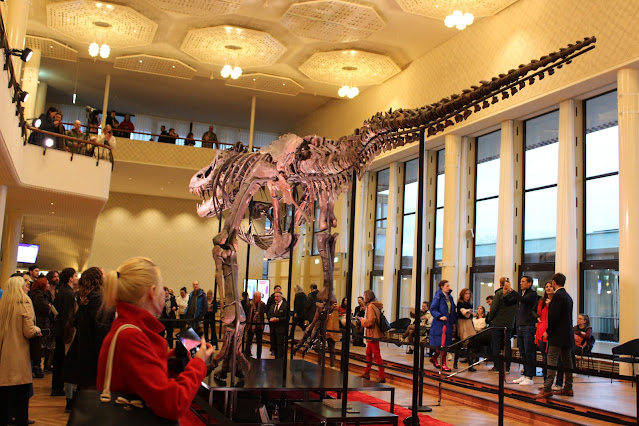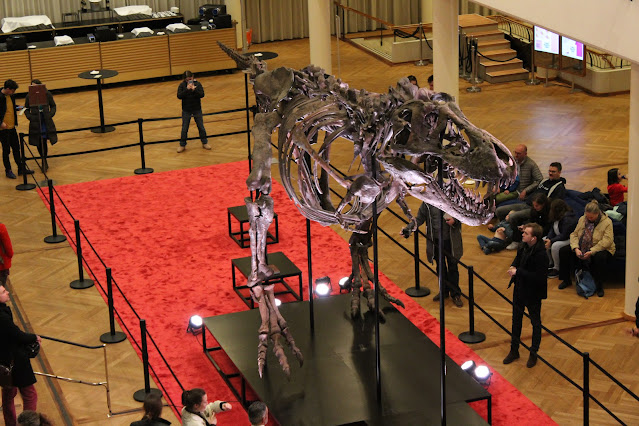Yours truly, up close with Trinity.
Lately, it really feels like the paleontology scene in Switzerland is booming. A bunch of new finds are being made in the Jurassic mountains and the Alps, completely unexpected taxa are being discovered, brand new species and genera are being named from old material that has been re-examined and now the world of private fossil collections has also had its one-of-a-kind spotlight (if the latter is a good thing we will get back to later).
While not
the first major dinosaur skeleton in general (that honour goes to some
allosaurs and diplodocids in Paris), “TRX-293 Trinity” is the very first Tyrannosaurus rex skeleton to be
auctioned off in Europe and has thus had quite the media attention. Koller
Auktionen displayed the fully assembled skeleton in the Tonhalle Zürich, where
people (including potential buyers) could book a visit to inspect the skeleton
before its official auction on April 18. I had the great opportunity to go look
at it too, which I used to take as many photos of it as possible, far more
than I could fit into a single post. I have some extra ones on my Instagram.
The skeleton is being sold by the Wunderkammer Gallery of Zürich, whose current head is one Christian D. Link, who apparently had worked beforehand as a magician for twenty years. Trinity is part of a wider auction gallery called “Out of this World”, which will also sell a variety of other curiosities, including fossils, meteorites, vintage astronaut gear and movie props. How exactly the gallery had acquired the bones which make up Trinity has been a bit difficult to discern from the information that has been available to me, though it seems to have originally been part of a private collection from the United States.
TRX-293 consists of 50.17% original fossil material. The full skeleton is 11.6 metres long and stands 4.37 metres tall. It is called Trinity because the original bone material is actually composed of three different specimens. Most of the body comes from the specimen “Garfield County 2”, which was excavated in 2013 in the Hell Creek Formation of Montana. This was supplemented with material from “Garfield County 1”, which was found one year earlier from the same formation. The skull comes from the third specimen, which was found in 2013 in the Lance Creek Formation of Wyoming. Apparently some additional vertebrae and parts of the hindlegs from the same formation were also added (which makes one wonder if there are more rexes in Trinity than just three). The mount was assembled by fossil preparator Nils Knötschke, former scientific director of the Dinosaur Museum Münchenhagen. I briefly met Nils in person once during the test-assembly of Victoria at the Sauriermuseum. He’s a nice dude, check out his Instagram.
The exhibition of the skeleton was quite the event. There were a lot of people and even security guards. There were also two balconies of different heights from which I was able to photograph the skeleton. On the tables laid booklets containing the skeleton’s information, as well as flyers by the Sauriermuseum (which helped out with the assembly), advertising their new T. rex special exhibit, which you will probably get to read about here in the future. What was a bit odd about the exhibit was the music they chose to play in the background to create atmosphere. The use of the Jurassic Park theme was pretty obvious, but I also heard tunes from Jaws, The Good, the Bad and the Ugly, Pirates of the Caribbean and… Shrek? Do not get me wrong, I love Shrek, but what does he have to do with dinosaurs?
Commenting on the mount itself, everyone involved has done a pretty fantastic job. The original bones have been excellently preparated and the dinosaur is posed in a naturalistic striding pose. As gleaned from interviews, Nils also took great care to pose the arms in the correct, inclined position instead of the dreaded pronated bunny hands that still plague many older mounts.
Oh yeah, and I also took that hand-puppet I got from London with me. His name’s Dr. Spondylus and he was thrilled.
The T. rex in the room
Of course, this reportage would be incomplete without addressing a quite controversial topic, which is the question of how ethical it is to auction off a fossil of this calibre to (likely) private buyers. I have commented surprisingly little on this topic before, even though I myself own a little collection of fossils I found or bought myself. But most of that consists of invertebrates, which barely anyone cares for. Privately owning entire dinosaur skeletons is a whole other level that understandably has some quite problematic aspects to it. These are specimens that are exceedingly rare and often of high scientific value, so it becomes quite frustrating when they are owned by private, often anonymous people who sometimes do not even offer the possibility of having the specimens be examined by researchers. Some quite notable specimens that would offer us great insight have been blocked off from scientific study that way. On the other hand, sometimes public museums simply do not have the means or finances to dig out such specimens or to preparate them, potentially leaving them exposed in the ground to erode away forever. Here I would like to quote Dr. Dennis Hansen (my boss) from the Zoological Museum of Zürich:
“For wealthy people who don’t know how to dig for dinosaurs, but who are still interested in dinosaurs and want to buy them, I see it the same way as art collecting. Art historians would also like every single important painting to be in the public realm. But experience has shown us that sooner or later that happens anyway. There are enough dinosaurs out there for everyone. Basically, there are just not enough people digging for them at the moment. And any dinosaur that is unearthed in the US, at least on private land, is fair game for sale. If it’s bought by a private collector, sooner or later, experience shows time and time again that it ends up in a public museum anyway. Many of today’s large public museums in major cities were started by private collectors, or their collections were built up around private collections. You need to have both private and museum collectors, because it’s a little bit of a symbiosis, and simply seeing it as black and white is really not productive to my mind. And dinosaurs are not dug up from deep below the surface. When you find a dinosaur, it’s because it's already eroding away. If no one comes to along to dig it out within two or three generations, it will completely disappear anyway. So if we have to wait two or three generations for a private collector or their grandchildren to donate it to a museum, that’s fine. I mean, the dinosaur is already 66 million years old. What’s a few human generations between friends?”
While I do not fully agree with Dennis that it is purely a question of time*, he at least offers a more positive outlook. After all, the T. rex Stan, who in 2020 was sold to an anonymous buyer for almost $32 million is now planned to return a museum again (the Natural History Museum of Abu Dhabi, which is still under construction), so there are plenty of precedents for this even in recent times. One also has to ask how much scientific value Trinity offers, given how, unlike Stan or Sue, it is not a single near-complete skeleton but a chimaera of multiple individuals. Of course, each individual bone offers data that is of value, depending on what one is looking for, but a complex life history can probably not be gleaned from this specimen as can be done with complete dinosaurs like Big Al. Similar to Dippy, Trinity is more of a showpiece.
*One has to ask for example what happens when a rich family simply refuses to donate a specimen even if the original buyer dies, they somehow lose it, damage it or do not keep up with its documentation. Legally, there is nothing that would prevent one from buying an original Van Gogh and scribbling a bunch of stickmen on it, since one can do with their property what they want.
Trinity will be auctioned off on the 18th of April. Its estimated value
is between 5 and 8 million CHF (5.4 – 8.6 USD). Included with the skeleton will
also be a bone-map of the mount, photos from the field and the dig sites, a
quarry map of one of the specimens and the right to reproduce the original
bones. The bidding, I heard, will start at 4 million. Who do you think will buy
it? Who do you hope will buy it? What would you do with this skeleton if you could have it?
If you liked this and other articles, please consider supporting me on Patreon. I am thankful for any amount, even if it is just 1$, as it will help me at dedicating more time to this blog and related projects. Patrons also gain early access to the draft-versions of these posts.
Related Posts:
- Gresslyosaurus: The Eldritch Dinosaur that turned its Discoverer insane?
- Visiting the Sauriermuseum Aathal - Part 1: The Howe Quarry Dinosaurs
- Behind the scenes of the Sauriermuseum, with Victoria the Hesperosaurus
- Diplodocus: A history of reconstructions - Part 1
References:

















.JPG)







No comments:
Post a Comment